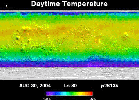
AnimationThis movie shows the daytime temperature of the surface of Mars as measured by the Thermal Emission Spectrometer instrument on NASA's Mars Global Surveyor orbiter. These temperatures clearly show the growth and retreat of the martian northern and southern polar ice caps. The caps grow in winter and are composed of carbon dioxide ice with temperatures as low as minus 125 degrees Celsius (minus 195 degrees Fahrenheit). In the summer the caps retreat to relatively small areas around the poles. The movie also demonstrates the large difference in temperatures between the northern hemisphere's summer (beginning when solar longitude, or Ls, is 90 degrees) and the southern hemisphere's summer (beginning when Ls is 270 degrees). This difference is because the orbit of Mars around the Sun is more elliptical than Earth's orbit. As on Earth, a hemisphere's summer is when that hemisphere is tilted toward the Sun, but on Mars, the planet's distance from the Sun varies much more than on Earth. Mars is closest to the Sun, and therefore warmest, during the southern summer season. In northern summer, when Mars' northern hemisphere is tilted toward the Sun, the planet is farther from the Sun.
Seasons on Mars are determined by the position of Mars in its orbit around the Sun. The position is measured in degrees of solar longitude (Ls) around the orbit, beginning at 0 degrees Ls at the northern spring equinox, progressing to 90 degrees Ls at the start of northern summer, 180 degrees Ls at the fall equinox, 270 degrees Ls at the start of northern winter, and finally back to 360 degrees, or 0 degrees, Ls at the spring equinox.
The Thermal Emission Spectrometer is operated by a team led at Arizona State University, Tempe. Mars Global Surveyor left Earth on Nov. 7, 1996, and began orbiting Mars on Sept. 12, 1997. JPL, a division of the California Institute of Technology, Pasadena, manages Mars Global Surveyor for NASA's Science Mission Directorate, Washington.

